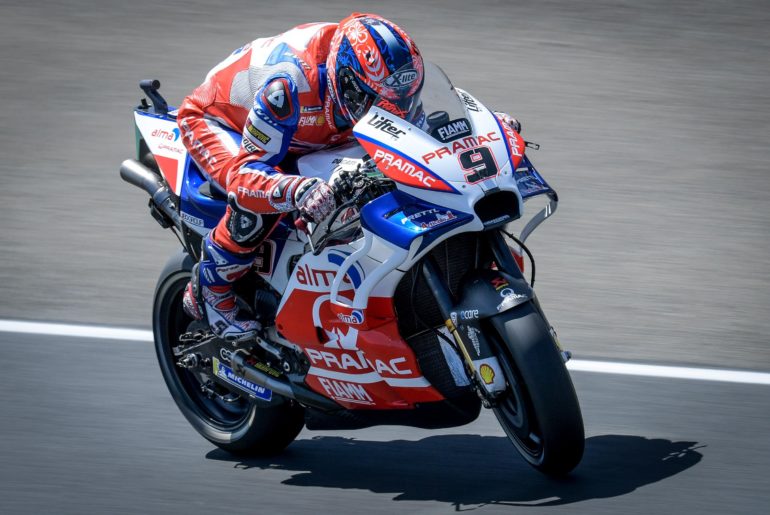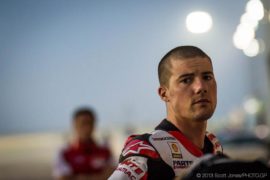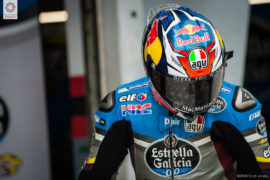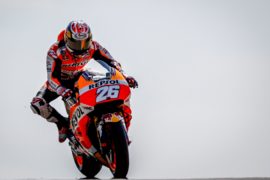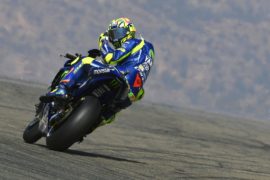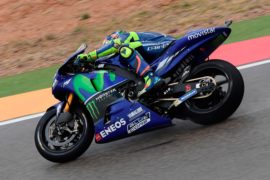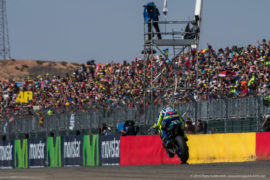Pressure comes in many different varieties in motorcycle racing. There is always the internal pressure to perform, of course, but that is natural. Without that, there are no results.
There is external pressure from the team, who want to succeed just as badly as the rider does. There is pressure from sponsors, who want to know their money has been well spent.
There is pressure from friends and family, who want to see a rider succeed, and from the fans, who will on their favorite riders. How a rider handles this pressure is usually the difference between success and failure in MotoGP.
Then there are occasions when the pressure rises to bursting point. When fighting for a championship, for example, when riders both need to win, but at the same time, they can’t afford to fall off.
Or at a rider’s home race, when the fans, the media are all willing you on to win, and show a lack of understanding if that doesn’t happen. How a rider handles this pressure is the difference between being a very good rider and being a great champion.
Riding at home can create extra pressure, especially if you are the only rider representing your country of birth. When it comes to home races, Spanish and Italian riders are at an advantage.
The pressure they have on them is much less than some of the other nationalities in MotoGP. Firstly, they have multiple attempts at getting it right at their home race. With four races in Spain and two in Italy, riders know that if they don’t do well in their first home race, they will get another shot at a second race.
Secondly, and perhaps more importantly, there are plenty of riders to share the stress with. At Mugello in two weeks’ time, fans will come to see Valentino Rossi win, but will be just as happy if Andrea Dovizioso wins, or Andrea Iannone, or Danilo Petrucci, or even Franco Morbidelli.
Two weeks after that the fans will be cheering for Marc Márquez, Dani Pedrosa, Jorge Lorenzo, the Espargaro brothers, Alex Rins, Tito Rabat. There isn’t the focus on one rider, who has one race to get everything just right.
Release the Pressure
So for Johann Zarco, the only French rider in MotoGP, to take pole at his home Grand Prix at Le Mans, the only race in France, is an achievement not to be underrated.
Not only did he hold his nerve, he pushed beyond the reach of his rivals to utterly shattered the existing pole record, beating the previous benchmark set by Jorge Lorenzo in 2016 by over eight tenths of a second.
Fellow front row riders were impressed, but unsurprised by just how well Zarco had ridden. He has experience, Marc Márquez explained. “I think he already has experience about this,” Márquez said.
“Of course when he was in Moto2 and he stayed there one more year, you learn many things when you try to defend a world title. He already did, and did in a correct way. So, he has enough experience.”
“When we are in Spain it’s many riders there in front but it’s only him, only one French rider there in the top. Of course everybody expect a lot from him. But he has experience and he can manage well. I hope that he doesn’t manage too well. But you need some pressure.”
It wasn’t so much pressure as another source of motivation for the Frenchman, Danilo Petrucci, third on the Pramac Ducati, explained to the press conference. “I hope that some pressure will appear in his face tomorrow, but Johann is a great rider,” he said.
“I think he will not have a lot of pressure tomorrow, but an extra motivation. So I think when we are everybody under pressure, but when we start the bike we forget everything. I think it’s a great pride to start the home Grand Prix on pole.”
Pressure Turns into Motivation
Andrea Dovizioso, starting tomorrow’s race from the middle of the second row, said he believes that Zarco simply turns that pressure into motivation. “I think that pressure helps Zarco,” the factory Ducati rider said on Saturday.
“I don’t know a lot about him, but I think that kind of pressure helps him to use his best potential. That’s why I think tomorrow he can fight to win with me, Marc, maybe some other riders for the victory until the end.”
Dovizioso knows that it is his turn next, when he turns up to Mugello for the MotoGP race he won last year. “AT the next round in Mugello for sure I will have pressure,” Dovizioso admitted, “but not in a bad way. I think that kind of pressure, like last year where I fight for the championship, I like that pressure.”
“I’m in my position, so I don’t feel I have to do the result because it’s the only chance I have. Is something strange. I don’t live in this situation in a strange way.”
“It’s stressful for everybody. Is normal, but most of the time the pressure, there is a possibility to use the pressure in a positive way. It’s very important to try to do that.”
For someone starting from fifth, at a track where it is notoriously difficult to pass, Dovizioso was remarkably sanguine. “The feeling is really good, so that’s why I’m relaxed,” he explained.
“This morning I didn’t put the tire, so that’s why I was 15th, but my pace was really, really good. It’s really nice to have a chance to make one practice and don’t put a new tire at the end, because you are able to use the first five minutes to work on the bike.”
“This makes a big difference. One exit more than normal to work on the bike most of the time makes a big difference. This is what happened.”
That, and a couple of mistakes on his fast lap, the Ducati rider said. “In the qualifying, I expected more. I had the chance to be faster, but the first two slips I wasn’t aggressive enough. When I brake, I immediately understood I brake too early. I couldn’t make a perfect lap like this.”
“But split three and four I did really good the speed. At the end, fifth position is fine. The lap time was fast from everybody. I don’t think it’s a big problem here to start in the second row.”
“That’s why I’m not too disappointed. Also because we know we can make a better lap time, but apart from that, the pace for the race I think is pretty good.”
The Pace
Looking at the timesheets in FP3 and FP4, it is clear that Dovizioso’s confidence is justified. He may only have finished 15th in FP3, but he banged out a 1’32.5, on a rear tire with close to race distance on it.
Those around him had all used a fresh tire to go and chase a lap time, offering good disguise to Dovizioso.
Dovizioso already knows who he expects to be doing racing against on Sunday. “I think Zarco has a really good pace. I think he will be very strong tomorrow. I saw him riding and he’s very motivated. I think he will be one of the riders being able to fight for the podium and the victory.”
“Also Marc I think will be very fast because he’s able to use the best potential of the bike. I don’t think he has the best pace, but he’s really good to manage every situation and in the race he’s always there. We have a really good pace.”
“There is a few other riders with very similar pace as us, but you can’t know if they did the pace in a relaxed way or if they are on the limit. Just in the race you can understand really if they can stay there, or they were towards the limit and they can stay for the 27 laps.”
The timesheets tell you something, but not everything about the way a rider makes a lap.
Behind those three – a rough guess is that they can run pace of about 1’32. 5 for a large part of the race – looms a larger group who are a couple of tenths a lap slower than the top three or so.
The Movistar Yamahas were in decent shape, but not quite competitive enough to match the pace of Zarco, Márquez, and Dovizioso.
Factory Yamahas
That left Maverick Viñales slightly despondent. He had been quick in the morning, when the track temperatures were nearer 19°C, but in the afternoon, once temperatures rose, Abraham suffered the same problems he had last year.
“Exactly the same problem as before,” Viñales said.” Exactly as last year at all the tracks, so let’s see if tomorrow we can make something special.”
Viñales tried to take confidence from the fact that he had been so fast in the morning. “I think if my bike was like the morning I was able to fight for the pole,” he said.
“But like it was in the afternoon it was impossible to fight for the pole. I know the level I have, I know the rider I am. I know when the bike is working I am there.”
Knowing that he still genuinely could be fast if the conditions were right had given him a much-needed confidence boost. He just wished he had the conditions from the morning during qualifying and the race.
First Fallers
There were plenty of others who weren’t so pleased about it. There were six falls during FP3, and another four during the shorter afternoon FP4 session.
There were even four crashes in the 15 minute Q1 session, including a vicious highside which sent him to the hospital. There, they found that Crutchlow had suffered no serious injuries, but that he would need to be monitored, and he will choose whether to race or not Sunday morning.
The crashes were strange, because they seemed to happen without warning. “I can’t explain it,” Alvaro Bautista said, who had had a big crash in Q1.
“Looks like the track is good grip, but at the end it’s like you lose the grip but no warning. You don’t expect the crash, just you feel the grip and then boom, you are in the air. It’s very, very strange,” Bautista said.
Bradley Smith, never at a loss for words to describe anything related to motorcycle racing, explained what he thought had been happening.
“It’s strange because Michelin’s always been so strong on the rear, but somehow we have like a delay, a dead spot or something in the tire which basically there’s grip and then the moment that you pick it up or you ask a little bit too much, there’s almost like a dead spot here,” he said.
Where Do Crashes Come From?
The wind was a factor, Piero Taramasso of Michelin told us. The conditions at Le Mans have been almost ideal, bright sunny skies with only the very occasional cloud ruining the view.
But air temperatures have been low, and that has an effect on the heat in the tires. When riders exit pit lane, they first have to traverse the complex exit, then they spend the better part of 20 seconds on the right side of the tire, before finally flicking it left for Musee.
A tire which would have been at least 90°C in the tire warmers would have lost approximately 15°C by the time the bike actually entered the pits, and can drop to as low as 50°C when they finally enter Musee.
The crashes had also been caused by the great grip the new surface has at Le Mans, in an odd sort of a way. That dead spot Bradley Smith referred to was because a tire loses grip a lot more suddenly than on a worn surface.
“This is a phenomenon happening on the track when you have a lot of grip,” Michelin’s head of two-wheeled motorsport Piero Taramasso told us. “You have a lot of grip, so the tire is gripping, gripping, gripping, and then when you lose the grip is very quickly, suddenly. So you lose it, it’s very difficult to recover.”
It is a phenomenon which resembles stiction. For example, on a grippy surface, a table may be difficult to move. You can keep pushing at it for a while without anything happening, until suddenly it lets go and the table moves suddenly.
Photo: MotoGP

